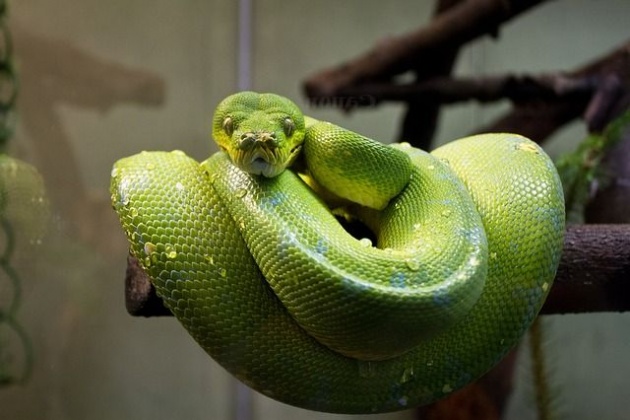
A green tree python is a non-poisonous, nocturnal, tree dwelling snake. The snake grows to an average length of 5 - 7 feet long. This unique snake originates from numerous parts of Indonesia, New Guinea, and North Australia. A green tree python lives in warm tropical climates and primarily resides within a rain forest.
Diet
The green tree python possess sensory pits that are located just above the top portion of the mouth. The pits look like small open spaces within the front of the mouth. The sensory pit provides detection of changes in the surrounding temperature allowing the snake to know when a cold or warm-blooded creature is approaching.
The green tree python typically eats any type of small rodent or mammal. The snake uses the sensory pits to hunt for birds while hanging from a tree, or to locate mammals and rodents while slithering through the ground decay.
The green tree python also eats birds and other reptiles, such as lizards. The snake’s normal resting position is a perfect attack-ready position. The snake hangs a couple parts of its body in the air draped over a large tree branch with leaves all around providing plenty of disguise. The snake wiggles the tip of its tail through the air which a lizard or bird mistakes as a worm or small snake.
The green tree python is able to eat animals that seem larger than the size of the snake’s mouth. The jaw muscles in the mouth are very elastic allowing the mouth to open significantly larger than the snake’s actual body size. The teeth of a green tree python are also larger, longer, and sharper than a typical snake, which are required for puncturing thick skin or dense bird feathers.
A green tree python is able to eat while dangling from a tree branch because the snake wraps several coils of its body around the prey, suffocating the animal to death. The snake uses its strong thick tail to wrap around the tree branch providing a sturdy anchor.
Life stages
The green tree python will hatch 15 - 25 eggs. The female will coil around the eggs providing protection and warmth. The snake lays her eggs in a hollow area elevated off the ground, such as the inside of a broken tree stump.
While the green tree python is young, its main color will consist of various shades of red, yellow, or blue with small intermittent stripes and spots along the entire body that are white, purple, brown, gold, or red.
When the green tree python grows to adulthood its color changes to a vibrant green, but some will change to blue, yellow, or red. A blue and white stripe often runs along the back of the entire length of the snake. Some types of green tree pythons, especially the ones that are not green, have sporadic spots along their entire body that are white, blue, yellow or red.
Dangers
The largest danger to the green tree python is a result of the destruction of the rainforest where they live because the snake does not survive outside of a warm tropical climate. Other dangers to the snake include hunting by large birds of prey, and indigenous tribes who utilize the snake for food, skin trade, and medical beliefs.
Captivity
The green tree python as a pet is a trend that is becoming popular. The set up requirements to care for the snake is specific and extensive. A green tree python will thrive within captivity and become extremely low maintenance. Captive green tree pythons will live for over thirty years, which is longer than the snake's life expectancy living in the wild.
Copyright © 2016 John Mallozzi



